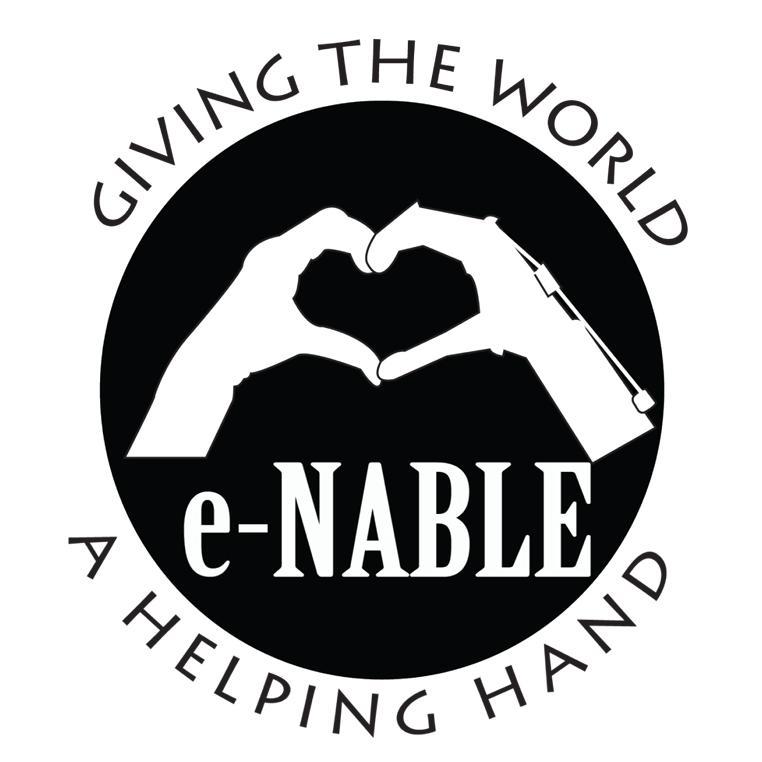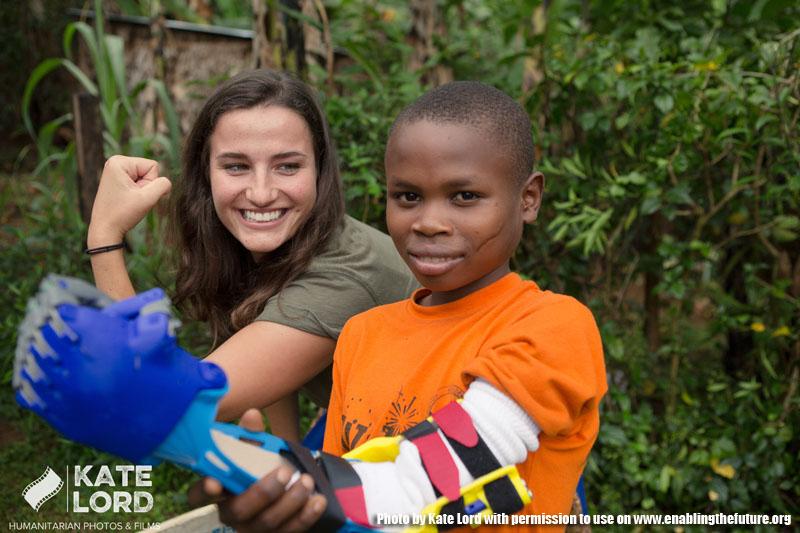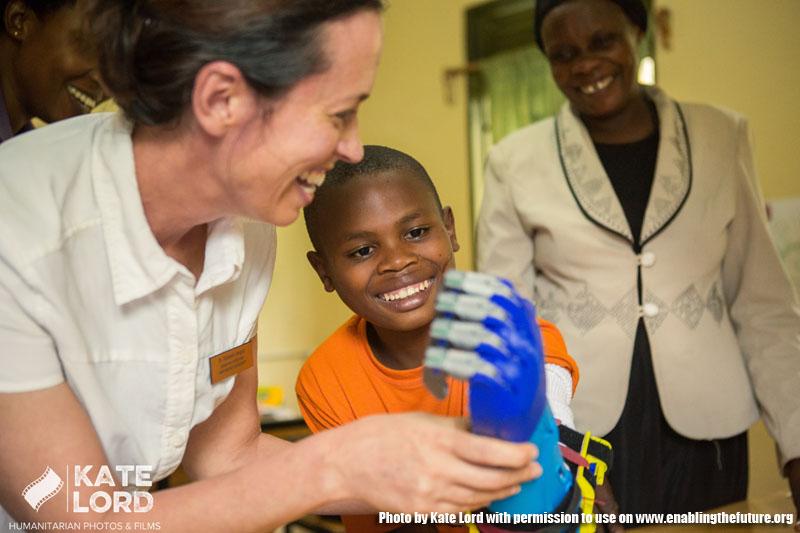 While we have the opportunity to follow some absolutely amazing stories here at 3DPrint.com, it’s hard to top the heartwarming feeling one gets just seeing the words e-NABLE. We always know something good is going to follow, and while there are certainly many individuals around the world undergoing many different challenges, seeing children living in impoverished areas regain functionality due to prosthetics is a positive all around, and something we never tire of hearing about. It’s obviously so fulfilling for these volunteers as a team around the world that they want to keep making these devices—thousands and thousands of times over. And thank goodness for them.
While we have the opportunity to follow some absolutely amazing stories here at 3DPrint.com, it’s hard to top the heartwarming feeling one gets just seeing the words e-NABLE. We always know something good is going to follow, and while there are certainly many individuals around the world undergoing many different challenges, seeing children living in impoverished areas regain functionality due to prosthetics is a positive all around, and something we never tire of hearing about. It’s obviously so fulfilling for these volunteers as a team around the world that they want to keep making these devices—thousands and thousands of times over. And thank goodness for them.
The latest recipient of an e-NABLE prosthetic is in Uganda, a focus lately for not just prosthetics and orthotics, but those of the 3D printed sort—with a story from that area we followed just recently as tech companies from Canada partnered to begin a program at CoRSU Hospital in Uganda. Now, another youth has a smile—and a very exciting new ‘Team Unlimbited‘ e-NABLE arm. Amos is a young, happy, and healthy boy who was unfortunate enough to lose both an arm and a leg when he was attacked by a wild animal. Despite the challenges, the e-NABLE team reports that he is a happy young man and loves to play soccer as well as dance. They also report that he has been ‘grinning from ear-to-ear’ thanks to his new prosthetic.’
 Amos is currently going to a primary school in Uganda, the Arlington Academy of Hope in the Bududa district of Uganda thanks to a program there with the non-profit group Arlington Academy of Hope (AAH), from the US. The 3D printed arm was made at MaryMount University after Dr. Elizabeth Langran told her associates there about his need for a replacement limb. When Dr. Langran had visited the school she met Amos personally and was inspired to see if indeed a device could be fabricated to help him regain functionality. When she went back, according to Maureen Dugan, executive director of AAH, she had the wonderful job of delivering the 3D printed arm.
Amos is currently going to a primary school in Uganda, the Arlington Academy of Hope in the Bududa district of Uganda thanks to a program there with the non-profit group Arlington Academy of Hope (AAH), from the US. The 3D printed arm was made at MaryMount University after Dr. Elizabeth Langran told her associates there about his need for a replacement limb. When Dr. Langran had visited the school she met Amos personally and was inspired to see if indeed a device could be fabricated to help him regain functionality. When she went back, according to Maureen Dugan, executive director of AAH, she had the wonderful job of delivering the 3D printed arm.
“In July I had gone on an advance trip for some planning of teacher workshops for AAH and for the AAH outreach schools,” explained Dr. Langran. “I spotted Amos, who has a prosthetic leg and had a stump below his left elbow. The AAH school is a special place, and in many parts of the world children with some type of physical limitation are frequently not in school. Since I knew my colleague Eric Bubar had been working with 3D printed upper limb e-NABLE devices, I approached him about the possibility of printing an arm for Amos.”
“I had asked Eric to record a few brief video clips of the printing of the arm. I decided we should show these first before bringing out the 3D printed arm, and it certainly got Amos curious. When I worked with Amos to grab a sock with his hand, Amos gave the biggest smile anyone had ever seen on his face. His arm was not truly strong enough to flex by himself, so he was helping it with his other hand, but a few days later at a school assembly he managed to flex it by himself. The principal had asked him to stand up and to thank ‘Dr. Eric’ for his work, and to remind other students to be gentle with his prosthetic and that disability is not inability.”
The photographer who took the images featured here, Kate Lord, said that she was visiting AAH with a program called She’s the First. She explains how much inspiration she gains from the kids upon visiting the school, and especially upon being the one there to photograph Amos when he was able to pick up the sock with his prosthetic for the first time.
”I first started doing ENABLE hands when I had a student that wanted to do a project on 3D printing about 2 years ago. She was interested in how the hands were printed and the University had just bought a low-cost 3D printer,” says Dr. Eric Bubar. “I challenged her to figure out if she could 3D print a Raptor Hand on our $500 Printrbot that looked like it came from a $3000 Makerbot! This was right before the e-NABLE Community’s Prosthetists Meet Printers conference at John’s Hopkins which my student attended and returned from with a good idea of how to assemble the hands and what they were supposed to look like.”
“She presented this work at an internal conference and student interest was HUGE. I decided to scrap my primary astronomy research and switch to printing hands right in the middle of my tenure pursuit (living life on the edge!). I started to print hands myself and have been involved with representing ENABLE at various events. I spent last summer getting more printers and teaching other faculty how to print as well (more on this in a moment). My research group began switching to 3D printing hands in the Fall of 2015 and has grown from roughly four astronomy researchers to forty hand printers (fall 2015) and fifty hand printers (spring 2016).”
Dr. Bubar points out what a huge enthusiasm the kids have for 3D printing—and this is definitely something we see on a constant basis as well. When they see also that 3D printing can make such an enormous impact on their lives, he says they are ‘definitely on board.’
“I’ve used many of these hands as demonstration pieces at various makerfaires and have started to expand into showing them to teachers at local schools (both elementary and high school). Occasionally I have even provided hand kits to high school clubs to get them engaged and involved,” says Dr. Bubar.
“Fast forward to teaching other faculty how to print, one of the faculty members I worked with (Elizabeth Langran) is an education professor who mentioned during her training that there was a student in Uganda (where she visits yearly to help out) who was in need of a full arm,” says Dr. Bubar. “We figured on a tentative plan for her to get measurements of Amos (the child who needed an arm) this year so I could possibly print an arm for him next year. Along came the release of the Unlimbited Arm. I printed a small test version and sent Elizabeth the measurement needs to see if maybe I could get something made for Amos this year. We got back measurements about two days before Liz’s departure date, and I kicked my printers into gear!”
Dr. Bubar explained that he made all the measurements and then referred to the documentation from Team Unlimbited. Upon doing so, he was able to figure out how to scale Amos’ arm appropriately, and his team set out to printing.
“Each piece was then printed using a variety of different printers and people (a real team effort!)” said Dr. Bubar, “My student (Max Hogan) printed the Phoenix hand pieces. I printed the Arm Cuff and tensioner system. A colleague in Interior Design (Doug Seidler) printed the gauntlet. The size of the pieces were large enough that they needed to be printed overnight. The next day, I came into work and all the pieces were ready—whew!”
“In between teaching, I managed to use the documentation videos to get the arm assembled and ready for delivery to Liz for transportation to Ghana. I bike to work, so I can imagine it was quite the site to see someone cycling along the bike trails with a robotic arm sticking out of his back pack! I delivered the arm to Liz that evening for her morning departure.”
Amos is obviously lucky not just in going to a school that is unusual and offers opportunity for children with physical challenges but also in being surrounded by so many inspired teachers, doctors, and visitors who would go the extra mile to make his quality of life so much better. e-NABLE asks that you click here for more information, as well as following them on Twitter, Facebook, and Instagram. That’s a great way to keep up with the countless amazing stories they are part of. And we too are thrilled to be able report on happy kids like Amos, as well as appreciating the hard work of so many volunteers around the globe who are certainly showing off the many benefits of 3D printing in the process. What are your thoughts on the amazing efforts shown here? Discuss in the 3D Printed Prosthetic Arm for Ugandan Boy forum over at 3DPB.com.
[Source: Enabling the Future]
Subscribe to Our Email Newsletter
Stay up-to-date on all the latest news from the 3D printing industry and receive information and offers from third party vendors.
Print Services
Upload your 3D Models and get them printed quickly and efficiently.
You May Also Like
3D Printing News Briefs, July 2, 2025: Copper Alloys, Defense Manufacturing, & More
We’re starting off with metals in today’s 3D Printing News Briefs, as Farsoon has unveiled a large-scale AM solution for copper alloys, and Meltio used its wire-laser metal solution to...
3DPOD 260: John Hart on VulcanForms, MIT, Desktop Metal and More
John Hart is a Professor at MIT; he´s also the director of the Laboratory for Manufacturing and Productivity as well as the director of the Center for Advanced Production Technologies....
3D Printing News Briefs, June 28, 2025: Defense Accelerator, Surgical Models, & More
In this weekend’s 3D Printing News Briefs, 3YOURMIND was selected to join an EU Defense Accelerator, and PTC has announced model-based definition (MBD) capabilities within Onshape. Finally, a study out...
EOS in India: AM’s Rising Star
EOS is doubling down on India. With a growing base of aerospace startups, new government policies, and a massive engineering workforce, India is quickly becoming one of the most important...



































